| |
 |
|
|

AVEIROARTE (Círculo
Experimental de Artistas Plásticos de Aveiro Experimental Circle of
Plastic Artists of Aveiro) and the Municipality of Aveiro are
responsible for the I lnternational Biennial of Contemporary Art.
This exhibition will take
place between the 11th of November and the 30th of December of 2006,
displaying works in the fields of Painting, Drawing, Engraving,
Sculpture and Photography. The jury awarded the € 10 000 (euros) Aveiro
Award to the painter José Maia, and honorable mentions in the following
categories: Photography: Dalila Vaz; Sculpture: Pascoal Ferreira and
Drawing: Inês Pessanha. In this first edition, and due to the quality of
the projects which were presented, the Jury decided to highlight, among
others, the works of Diana Costa, Elisabeth Leite and Mário Vitória.
Regarding
some of the works on display
Two universes, the landscape and the portrait,
dominate the selrected projects
|
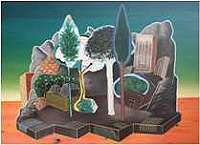 |
The pretext-Iandscape
expresses a model of idealized knowledge in the work by José Maia,
winner of the Aveiro Award. The rationality, which is supposedly
associated with sight, "disqualifies any pretense of natural
perception in detriment of a reference to traditional elements in
the history of art. Whether it be in terms of genre, electing the
landscape as its theme, or in terms of construction and composition
of the representation, when he draws an horizon whose genealogy
takes us to the geometry of the horizontal line arising from the
rationalistic demand of spatial representation. Over that line, José
Maia projects an island-Iandscape, a kind of catalogue of fantastic
geologies and floras, thus exploring the total limits of a gaze
seduced by the objects, images and horizons of a place oblivious of
reality. A landscape, that is capable of retaining the vision and of
becoming, due to its alleged unreality, more of a landscape than the
landscape itself. |
| |
|
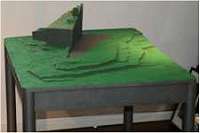 |
"Repasto..." (Banquet)
and "Colonização" (Settlement) by Pascoal Ferreira honorable
mention in the field of Sculpture has also used the landscape as its
theme and constructive element. The table and the chair, apparently
mere structures of support, are nourished by the symbols associated
to these two objects. The viewer is invited to digest the banquet
that the landscape offers him, with his gaze, and to settle the
space where he sits in order to do so. |
| |
|
 |
The drawings of
Inês Pessanha, recipient of the honorable mention in the field
of Drawing, also present landscapes that possess a distinctive
character. A landscape, that stems from a concept and then expresses
itself through gestures and the overlay of images. The strategy is
that of the creation of obstacles to the identification of what is
presented; the feasibility reveals itself in the process of the
chaotic overlay and accumulation of linear references and stains; a
proposal of understanding is suggested by means of a stratified
reading. It is a continuous process of re-education of the gaze,
methodologically selective, which leads to the (re) construction and
perception of images. |
| |
|
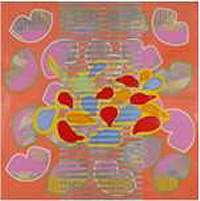 |
Using a visual
language that reproduces an interior objectivity, the two paintings
presented by Diana Costa are, in themselves, a process of
resemblance to the materials that, as a whole, constitute registers
of intimate routes to which the signs of an urban geography are no
strangers. Both paintings, "Recomenda-se um a três sorrisos por dia"
(We recommend one to three smiles a day) and "Sputnik meu amor"
(Sputnik my love), are part of a series entitled "Second First
Impression". A type of spatial ontology, these paintings can,
because of that, and as a genre, be associated to a comprehensive
notion of landscape. On one hand, they reflect an interior horizon,
while they explore and register moments, pleasures or
dissatisfactions; on the other, they express an external landscape,
by delineating borders, circumscribed or open spaces, the overlay
and stratification of colors, gestures and diversified registers.
Diana Costa considers that the landscape is also a form of knowledge
and not an illustration of reality. |
| |
|
|
From the horizontal,
main characteristic of these landscapes, we now follow another
constant direction, the verticality commonly associated to the
portrait. |
| |
|
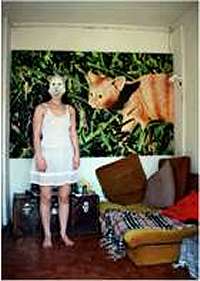 |
We should like to
highlight the honorable mention in the field of photography awarded
to Dalila Vaz. The language of the objects, the empirical
experience of the spaces in that, wich is their expression, texture,
color and local history are the starting point of the experience
which the photographer undertakes. Going in a direction that she
claims does not control and which occurs at random when questioning
her gaze or the impression caused by the spatial truth. The result
is an union between the photographer and that, which is photographed
in a process of deconstruction, where the reinvention of different
universes is assumed. The usage of the mask as a fake body, thus
becomes the real face, also present in the photography that is used
as a frame in one of the images. The methodology which is apparently
expressed is not proposed as such. All happens naturally. |
| |
|
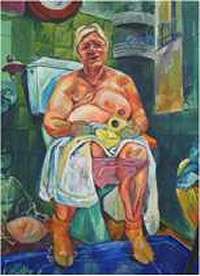 |
Elisabete Leite
also chose the portrait as her subject of thought and reflection. ln
'Acessórios" (Accessories), the viewer is confronted with the
realistic image of an elderly woman sitting in a bathroom surrounded
by accessories described topographically. The laundry basket, the
roll of toilet paper which she holds in her right hand, the floor
mat, the soap dish, several containers placed in a metallic basket
suspended in one of the corners of the room or a dressing gown
folded over her knees covering part of her naked body. The irony of
the representation is in the title chosen for the piece that
initially captures the viewer at a glance towards elements which are
secondary to the main theme that of that of amputation, in this
specific case, a mastectomy. This painting is part of a series
dedicated to the theme of amputations, and is the follow-up to a
series about obesity. The artist has no intention of theorizing the
themes she chooses; they are merely the pretext to express deformity
through painting, a means to portray the transformation of the body
due to mutilation. |
| |
|
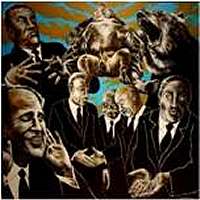 |
Finally, Mário
Vitória's work, "Santíssima Trindade" (Holy Trinity), portrays the
alleged ritual of the covenant made between the Father, the Son and
the Holy Ghost. Following a centralized compositlon, the narrative
is developed based on a central core of three figures. Above them,
an obedient man-dog lies submissively with his belly up; to the
right, a bear more human than Man itself howls as a means of protest
towards agreement. Three other figures, the same represented in the
centre, are distributed in the remaining pictorial surface space
balancing the displayed forces of tension. One of the characters is
laughing, placing his hands over his ears like somebody who claims
that he is not hearing. Another one places his hands in the shape of
a shell claiming that he knows nothing, and finally, the third one,
in the left-hand top corner, reveals an exempt from responsibility
expression. The underlying moral is obviously a metaphorical
criticism to international political and economical agreements that
do not spare any means in order to attain their goals.
|
|
|
Ana Luísa Barão

|
|
O Círculo
Experimental de Artistas Plásticos de Aveiro – AVEIROARTE – e a Câmara
Municipal de Aveiro organizam a I Bienal Internacional de Arte
Contemporânea, que decorre entre 11 de Novembro e 30 de Dezembro de
2006. Abrangendo os territórios da pintura, desenho, gravura, escultura
e fotografia, foi atribuído pelo júri o Prémio Aveiro, no valor
de 10 000€, ao pintor José Maia; e as menções honrosas, nas categorias
de fotografia, a Dalila Vaz; de Escultura, a Pascoal Ferreira; e de
Desenho, a Inês Pessanha. Nesta primeira edição, e pela qualidade dos
projectos apresentados, o Júri decidiu destacar, entre outros, os
trabalhos de Diana Costa, Elisabeth Leite e Mário Vitória.
Sobre algumas das obras em destaque
Dois universos, o da paisagem e o retrato dominam os projectos
seleccionados.
|
 |
Uma paisagem-pretexto enuncia em
José Maia, vencedor do Prémio Aveiro, um modelo de conhecimento
idealizado. A racionalidade supostamente associada ao olhar
desclassifica qualquer pretensão perceptiva de ordem natural em
detrimento da referência a elementos tradicionais da história da
arte, quer em termos de género, elegendo a paisagem como temática,
quer em termos de construção e composição da representação, quando
traça uma linha de horizonte cuja genealogia nos leva à geometria da
linha horizontal fruto da exigência racionalista da representação
espacial. Sobre essa linha José Maia projecta uma paisagem-ilha, uma
espécie de catálogo de geologias e floras fantásticas, explorando,
deste modo, todos os limites de um olhar seduzido pelos objectos,
imagens e horizontes de um lugar ausente da realidade, uma paisagem
capaz de reter a visão, e de se tornar, pela sua suposta
irrealidade, mais paisagem que a própria paisagem. |
| |
|
 |
"Repasto…” e “Colonização” de
Pascoal Ferreira – menção honrosa de escultura – têm também como
temática e elemento construtivo a paisagem. A mesa e a cadeira,
aparentemente meras estruturas de suporte, são nutridas pela
simbologia associada a estes dois objectos. O espectador é convidado
a digerir com o olhar o repasto que lhe oferece a paisagem e a
colonizar o espaço onde se senta, para o fazer.
|
| |
|
 |
Paisagens de um carácter distinto
são também os desenhos de Inês Pessanha, vencedora da menção
honrosa de desenho. Uma paisagem que parte de um conceito e se
expressa na gestualidade e sobreposição de imagens. A estratégia é a
da criação de obstáculos à identificação do representado; a
exequibilidade revela-se no processo de justaposição e acumulação
caótica de referentes lineares e manchas; uma proposta de
compreensão indicia-se numa leitura estratificada. Trata-se de um
processo contínuo de reeducação do olhar, metodologicamente
selectivo, que conduz à (re)construção e percepção de imagens. |
| |
|
 |
Usando uma linguagem visual que
reproduz uma objectividade interior, as duas pinturas de Diana
Costa são, em si mesmas, um processo de aproximação aos
materiais que, no seu conjunto, constituem registos de percursos
íntimos a que não são estranhos indícios de uma geografia urbana.
Ambas, “Recomenda-se um a três sorrisos por dia” e “Sputnik meu
amor”, fazem parte de uma série intitulada “Second First Impression”.
Espécie de ontologia espacial, estas pinturas podem, por isso mesmo,
e enquanto género, ser associadas a uma noção abrangente de
paisagem. Se por um lado, reflectem um horizonte interior, enquanto
exploram e registam momentos, prazeres ou insatisfações; por outro,
enunciam uma paisagem externa, ao delinearem fronteiras, espaços
circunscritos ou abertos, sobreposição e estratificação de cores,
gestos e registos diversificados. Para Diana Costa a paisagem é
também uma forma de conhecimento e não ilustração da realidade. |
| |
|
|
Da horizontal, característica
primeira destas paisagens, seguimos agora outra orientação
constante, a verticalidade, usualmente associada ao retrato. |
| |
|
 |
Destaque para a menção honrosa de
fotografia atribuída a Dalila Vaz. A linguagem dos objectos,
a vivência empírica dos espaços naquilo que é a sua expressão,
textura, cor e história local constituem o ponto de partida para a
experiência que a fotografa leva a cabo, numa direcção que diz não
controlar e que ocorre ao sabor das interrogações sobre o seu olhar
ou sobre a impressão causada pela verdade espacial. O resultado é
uma fusão entre fotógrafa e fotografado num processo de
desconstrução que pressupõe uma reinvenção de diferentes universos.
O uso da máscara enquanto corpo falso torna-se a face verdadeira,
presente também na fotografia que serve de enquadramento numa das
imagens. A aparente metodologia enunciada não é proposta enquanto
tal. Tudo acontece naturalmente graças uma empatia espontânea que se
estabelece entre a artista e o espaço que a envolve. |
| |
|
 |
Elisabete Leite
elegeu também o retrato como matéria de reflexão. Em “Acessórios”, o
espectador é confrontado com a imagem realista e crua de uma mulher
de idade avançada sentada num sanitário circundada por acessórios
topograficamente descritos – o cesto da roupa suja, o rolo de papel
higiénico que segura na mão direita, o tapete, a saboneteira,
recipientes vários colocados numa cesta metálica suspensa num dos
cantos da divisão ou um robe dobrado sobre os joelhos que lhe
encobre parte do corpo nu. A ironia da representação está no título
escolhido para a peça que desvia, num primeiro instante, o olhar do
espectador para elementos que são no fundo secundários face ao tema
central – o da amputação, neste caso específico, uma
mastectomia. Esta pintura faz parte de uma
série dedicada ao tema das amputações e vem na sequência de uma
outra sobre a obesidade. A artista não pretende problematizar as
temáticas que escolhe, elas são apenas o pretexto para pintar a
deformação enquanto expressão, uma forma de retratar a transformação
do corpo perante a mutilação. |
| |
|
 |
Por fim, a “Santíssima Trindade” de
Mário Vitória retrata o suposto ritual do pacto realizado
entre o Pai, o Filho e o Espírito Santo. Seguindo uma composição
centralizada, a narratividade desenvolve-se a partir de um núcleo
central de três figuras. Sobre elas, um obediente homem-cão
encontra-se submissamente deitado de barriga para cima; à direita,
um urso mais humano que o próprio Homem urra como forma de protesto
face à concertação. Três outras figuras, as mesmas que foram
representadas ao centro, distribuem-se pelo restante espaço da
superfície pictórica equilibrando as forças de tensão que nela se
desenham. Um dos personagens ri, colocando as mãos nos ouvidos como
quem diz nada ouvir, outro coloca as mãos em forma de concha
afirmando que nada sabe e finalmente o terceiro, no canto superior
esquerdo, revela uma expressão de desresponsabilização. A moral
subentendida é obviamente uma crítica metafórica aos pactos
político-económicos internacionais que não olham a meios para obter
os fins desejados. |
|
|
Ana Luísa Barão |
|
|
|
|
|